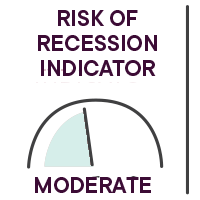Yann Furic
B.B.A., M. Sc., CFA®
Senior Portfolio Manager, Asset Allocation and Alternative Strategies
What moved the markets:
No rate hike from the Bank of Canada.
Slowdown of the Canadian economy.
U.S. economy stabilizing.

|
OVERVIEW OF GLOBAL EQUITY MARKETS |
||||
|
Country |
Index |
Return |
Change |
Year-to-date return |
|
Canada |
S&P/TSX |
7.48% |
|
7.54% |
|
United States |
S&P 500 |
6.59% |
|
20.88% |
|
|
Nasdaq |
8.25% |
|
37.09% |
|
International stock markets |
EAFE |
6.73% |
|
12.35% |
|
Emerging markets |
|
5.48% |
|
5.77% |
|
China |
MSCI China |
0.13% |
|
-8.94% |
* All percentages are in Canadian dollars. Source: Morningstar Direct.
Results – Canadian bonds
The FTSE Canada Universe Bond Index posted a positive return of 3.15% year to date (as of November 30, 2023).
Source : Morningstar Direct.
Our analysis of events

Markets enter rate-cut mode
Economic data are pointing to a slowdown, which means that rate hikes are finally having the desired effect. For example, more and more households are facing higher payments when renewing their mortgages, causing them to reduce spending in other areas. This reduction has a cooling effect on consumption and the economy as a whole, such that central banks in Canada and the U.S. are expected to cut rates starting in spring 2024.
This policy shift from major rate hikes to predictable cuts has led to widespread gains in equity and bond markets. Balanced portfolios saw their returns go up by more than 5% in November.
At its December 5 meeting, the Bank of Canada held the key rate at 5%. The Bank’s announcement notes that the economy and employment are slowing down and that demand for goods and services is no longer excessive.
On December 13, the U.S. Federal Reserve (Fed) confirmed market expectations and did not increase its policy rate, opening the door to rate cuts in 2024, but prepared to tighten its policy further if appropriate. Despite the repeated rate increases imposed by the Fed, the U.S. economy continues to grow.
Employment situation
In November, Canada’s unemployment rate reached 5.8%, up from 5.7% the month before and in line with market expectations. With 1.24 million Canadians out of work, the jobless rate is at its highest since January 2022. The labour market added 24,900 new jobs, beating the market consensus of 15,000. Wage inflation remained high at 5% over the past year.
In the United States, job gain beat expectations in November with 199,000 new positions rather than the expected 185,000. The unemployment rate went down from 3.9% to 3.7%, and wage inflation remained stable at an annual rate of 4%.
Economic indicators
Global Purchasing Managers’ Index ![]()
In November, PMIs once again showed a difference between the manufacturing economy, which is contracting, and the services economy, which continues to expand, although the pace is slowing.
Inflation rate ![]()
The inflation rate is still too high, but some indicators are headed in the right direction. Canada’s wage inflation is still too strong.
Benchmark rates in Canada, Europe and the United States ![]()
If interest rates remain at current levels for an extended period, they will have a major impact on household and business spending when loans are renewed. This will further dampen investment and personal consumption.

Our strategic monitoring
We maintained a cautious approach throughout 2023.
We are keeping track of inflation, in addition to leading indicators for manufacturing, services, and employment. A deterioration in these numbers would prompt us to be even more cautious.
Significant improvement in manufacturing indices, combined with a return to 2% inflation, would be a strong sign of not only economic recovery but a possible soft landing.
Fourth-quarter earnings estimates for S&P 500 companies are stabilizing, but valuations remain high.
Caution and risk management remain our priorities.
Our tactical positioning
In November, we increased the weighting of Canadian bonds relative to Canadian equities.
We also increased the weighting of Japanese stocks versus European ones, since Japan seems to have a better economic outlook.
Tactically, we maintained our position in U.S. large cap growth stocks, which react positively to stabilizing interest rates, as well as in stocks with a track record of dividend growth, which are more defensive.
We continue to favour large cap stocks in developed countries.
Since the Bank of Canada’s policy rate increase in early June, we have taken a position in 10-year Canadian bonds, since we believe that longer-term rates will peak over the next few months and then stabilize or decline.
We increased the weighting of 10-year Canadian bonds in July and August, the early days of October, and November.
To learn how our funds performed:
View the returns
Main risks
- Overly restrictive monetary policy could cause a major recession or other problems, like the U.S. regional bank crisis.
- High interest rates for an extended period would reduce corporate profits and sharply curtail household spending.
- The possibility of an episode of stagflation, that is, anemic economic growth and high inflation, remains. This would be bad news for stock markets.
- The Israeli-Palestinian conflict could have consequences throughout the Middle East.
- The conflict in Ukraine could spread to other European countries.
- Tensions could also worsen between China and the United States over Taiwan.
Senior Manager, Asset Allocation and Alternative Strategies
Data source : Bloomberg
The opinions expressed here and on the next page do not necessarily represent the views of Professionals’ Financial. The information contained herein has been obtained from sources deemed reliable, but we do not guarantee the accuracy of this information, and it may be incomplete. The opinions expressed are based upon our analysis and interpretation of this information and are not to be construed as a recommendation. Please consult your Wealth Management Advisor.




















